An Enactivist Account of Human Experience and Behavior
Your Experience is 'Situated'
At any given moment, you are in a situation. You can think of it as the setting for your experience. I invite you to take a moment to look at your hands – don't look down, bring them to eye level first and appreciate them, start on the back and then on the inside. Do not do it mentally, try doing it in real life. Now, look around the room or space where you are – no need to stand up, appreciate the collection of objects surrounding you. The more specific the better. If you are indoors, appreciate the furniture, the things standing on the floor and on nearby surfaces. If you have a window, appreciate the view. If you are outdoors, look at the scenery and the vegetation, appreciate the building closest to you and any other structures around. Please, do take a moment to look around. This is your current situation.
What you just appreciated in your situation is a base layer composed of 'media'. Every situation you may find yourself in has one. By media we mean any object, person, or structure that you can interact with to obtain a particular experience, even if just by looking at it. You can think of this media layer as the collection of objects that your situation is making available to you to interact with. Together and assembled the way it is, this media layer constitutes your immediate environment, a 'stage' of sorts where you are the performer in the story of your life.
At any moment – including now – the experiences you can have in this stage are entirely dependent on the interactions that happen between you and your environment. Please, look around again. In every object there is a different experience to be had. In fact, most objects offer multiple possible experiences because you can interact with them in different ways. If you mentally step back and consider all these possibilities at once, you'll see the space we will explore down ahead.
The Space of Possible Experience
The space of possible experience is defined as the set of every course of action available to you in the moment. For any situation, the space can be explored methodically by taking a closer look at the types of interactions that are possible with the immediate environment. Notice, however, that the idea of interactions doesn't convey direction – technically, you interact with your environment both, when you act upon it, but also when the environment acts upon you. This distinction is important to our discussion, so instead of interactions we will talk about 'engagement'. That way, we can distinguish between moments where you engage your environment and those where your environment is engaging you. The focus of our discussion here is the former, i.e., the experiences that arise when you engage your environment. They can be classified in three sets, explained below.
A BASE SET: CONTEMPLATION
The simplest experiences you can obtain in a situation come from contemplating the immediate environment [see the opening paragraph]. Contemplation is achieved simply by paying attention to any part or aspect of your surroundings. In this context, attention is equivalent to "selection for contemplation". You may select, for example, the scene as a whole, an object, or a group of objects (consider appreciating a sunset, kids playing in the park, artwork in a museum). When you engage your environment by deploying attention you are using what you could call attentional engagement.
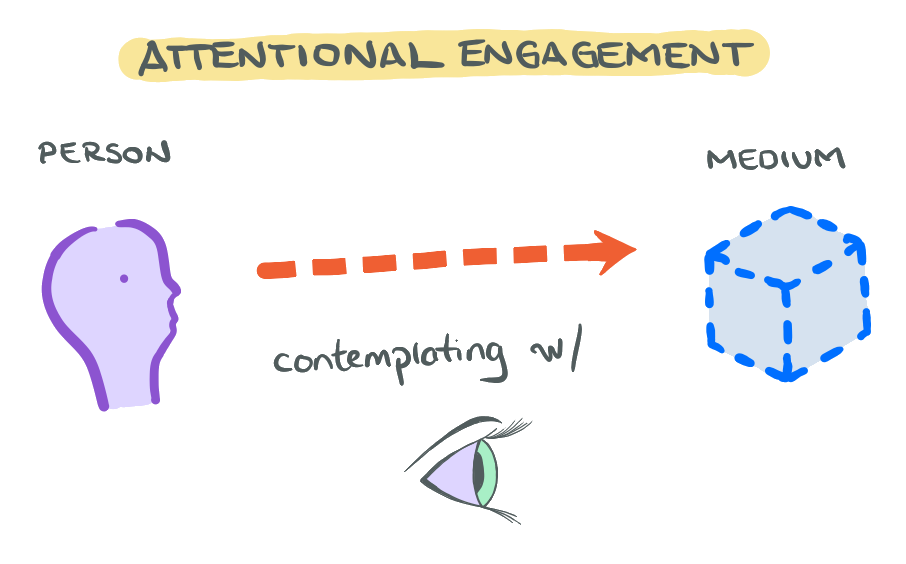 To contemplate a medium you have to engage it by deploying attention.
To contemplate a medium you have to engage it by deploying attention.* Note: Read Experience Delivery for more on why attention constitutes engagement.
AN UPPER SET: DIRECT ENGAGEMENT
The next set of experiences offered by your immediate environment can be accessed by deploying 'higher' forms of engagement. Higher engagement consists of actions performed by you onto your surroundings. These actions are for the most part directed at objects (consider lifting a box, opening a window). For you to be able to direct your engagement at an object, you first need to deploy attention – it is fair to say higher engagement is built on top of attention. In this context, attention becomes 'selection for action'. The experiences obtained through higher engagement are richer, they come with higher energy than mere contemplation.
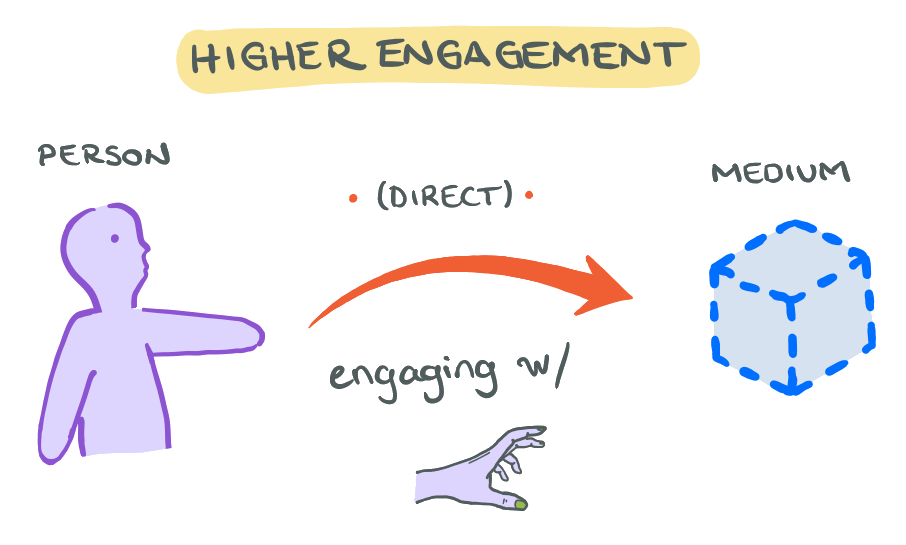 When you act on a medium, you are deploying higher forms of engagement.
When you act on a medium, you are deploying higher forms of engagement.
A HIGHER SET: MEDIATED ENGAGEMENT
Your immediate environment offers yet a third set of experiences. Like the second set, they are also accessed through higher engagement. It comes with a twist, however: Instead of simply engaging your environment directly (with your hands/body), you have to engage it using one of the objects around you (consider engaging a dartboard with a dart). It might seem like a small change, but this arrangement — 'mediating' your engagement — is how people obtain many, if not most of the experiences they enjoy every day.
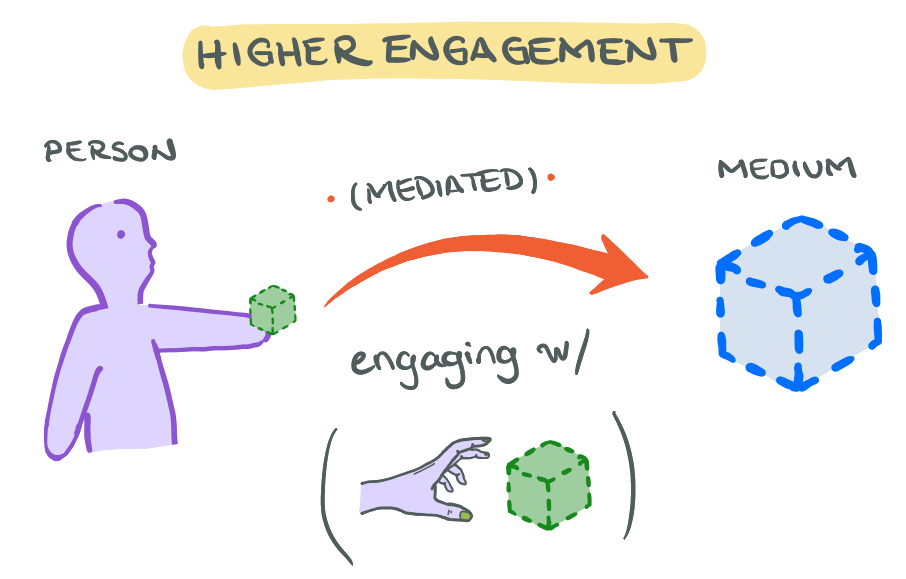 You mediate your engagement when you use an object to engage your environment.
You mediate your engagement when you use an object to engage your environment.
Experience = Felt Action = Felt Engagement
The significance of an idea like the space of possible experience is better appreciated when you remember that experience is a permanent phenomenon in human life – it is what you are having right now. Regardless of specific situation, you can shape your experience by following the three general courses of action laid above:
1) Contemplating the media around you
2) Engaging the media around you directly, or
3) Using the media around you to engage other media.
In Experiential Costs, it was argued that to 'experience' Reality is to have it 'feel like something' to you. Thinking of the three courses of action in these terms, you'll find that each of them produces a qualitatively different experience to you – a course of action is a course of experience. In other words, action – or engagement – is experience. But it is not how it looks, it's how it feels. Engagement, to us, 'feels like' experience. Experience is the embodied feeling of action/engagement.
Experience is the total feeling of engaging in course of action.
Media Sets Bounds and Extends Behavior Spaces
You experience the world by engaging it, but you cannot engage it in any way you want. To appreciate this, imagine yourself 'situated' in two different places:
1) Central Park in New York City
2) A barren desert landscape
Which place would you say offers more things to do? Central Park is a media-rich environment that offers natural sights with people and wildlife; there's grass lawns to lay down and trees to hide under, all adorned with a striking backdrop of high-rise buildings. The desert is, well, a media-poor environment that offers a view that looks the same in every direction, sand-dunes to sit on and play with, and not much else.
Comparing these two situations you can make the following point: Media makes engagement possible, it extends your options of possible behavior as much as it bounds and restricts them. If you want to do something – anything – the surrounding media has to afford that possibility. You can't grasp something that can’t be grasped, you can't climb something that can’t be climbed. In other words, your behavior is always fully complementary to the situation you are immersed in. That is why people look for media-rich environments, because media turns their surroundings into playgrounds of sorts.
Media affords engagement.
Affordances: Defining Possible Engagement
Media always affords engagement, but the specific ways in which you may engage a medium are not boundless. To understand the realm of possible engagement with any given object, you have to understand the concept of affordances. It's an established term meaning the 'action possibilities' or 'behavioral options' afforded by a medium. Consider the following situation:
You are in a room a winter afternoon. You see a pot of tea next to you, giving you the option to pour yourself some. You notice a huge pillow below, which gives you the option to put it behind you to support your back. You also have the option to pour tea over the pillow and make it wet, but you would not. You find a book under the pillow, now you can read it while you enjoy your tea. There isn't a dog in the room, but if there were you'd have the option to pet him, or offer him some tea, or read him the book, or play with him using the pillow.
In every object you can see 'options'. By way of being present in your situation, every object brings at your disposal (or 'affords') a number of behavioral options. The collection of these options and possible combinations gives rise to the space of possible behavior for that situation, which is no other than the space of possible experience discussed earlier.
It's essential to distinguish between two types of affordances:
- The affordances or behavioral options offered to you directly by a surrounding object (consider the action-object pairs, grasping-stick and pressing-button).
- The affordances or behavioral options offered to you by a surrounding object when you intend to engage using a different object (consider the action-object-medium triplet, pressing-button-stick, using the stick to press a button).
The distinction is important because the latter capture the notion of using media as 'tools'. The first type can be called variably 'handling' or 'direct' affordances. The second type can be called 'effecter' or 'mediated' affordances. As discussed in Experience Delivery, the concept of affordances was introduced by J.J. Gibson and popularized by Donald Norman. Although Gibson and Norman both recognized the value of using objects as tools, the formal distinction between direct and mediated affordances may be owed to Victor Kaptelinin (University of Oslo) and Bonnie Nardi (UC Berkeley). Consider the following diagram from their 2012 paper:
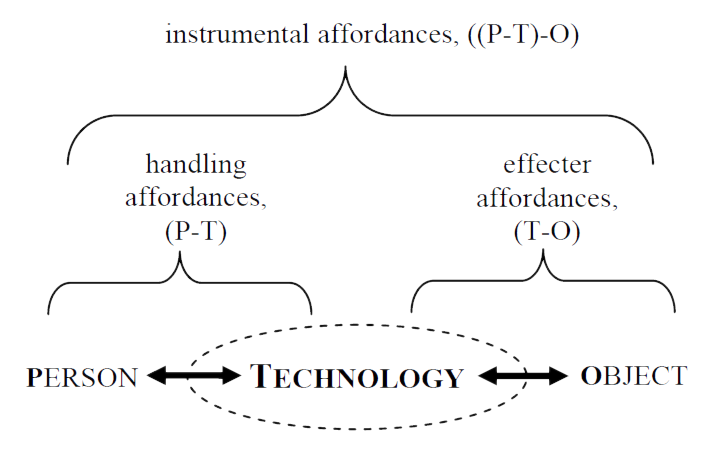 The affordances of Norman (perceived affordances) can be further categorized into handling and effecter affordances.
The affordances of Norman (perceived affordances) can be further categorized into handling and effecter affordances.
The Factorial Nature of a Behavior Space
Humankind's ability to use media to engage other media opens up a world of rich and diverse experiences by expanding behavior spaces in a non-linear way. Using a screwdriver as an example, theoretical biologist Stuart Kauffman points out the 'permutational' richness of behavior spaces in a 2011 feature for WBUR news:
"Try it with screwdrivers. Is there a finite list you can come up with for all possible uses of screwdrivers for untold purposes? You can screw in a screw. You can use the screwdriver to open a can of paint. You can use the screwdriver to wedge a door closed, or open, or scrape putty from a window, or stab an assailant, or a friend, commit suicide, or as an object of art, or tie it to a bamboo pole and spear fish, or rent the spear to others and collect 5 percent of the catch, or with a rock, chop (slowly) down a small tree, or carve a stick (...)"
The coupling of affordances between objects enables engagement that is 'mediated'. At play is the notion of engaging the world through media. Mediating our interactions with Reality has become a crucial aspect of the human experience. Practically all progress in transportation, healthcare, communication, and entertainment can be explained as some form of mediated engagement. In the year 2020, people engage roads with cars and skies with planes; they engage friends through social media and colleagues through systems like Slack and Zoom; they engage celebrities through screens, immune systems with vaccines, and the universe with rockets, robots, and telescopes. Kaptelinin & Nardi appreciate this on their 2012 book:
"Human beings seldom interact with the world directly. An enormous number of artifacts has been developed by humankind to mediate our relationship with the world. Using these artifacts is the hallmark of living the life of a human being. Tools or instruments—physical artifacts mediating external activities—are easy to recognize and their impact on the everyday life of every individual is obvious." (Activity Theory in HCI, p. 15)
Mediated Engagement is Technology
The most consequential forms of mediated engagement happen by forming 'chains' of mediation. You can see these chains at work in the systems that sustain life and order across the globe, be them political (e.g., representative forms of government), economical (e.g., division of labor, supply chains), or technological (e.g., machines, software, the Internet). We can think of every chain of mediation as a form of technology.
As the art of doing things with things, technology is inseparable from media. In addition to chains of mediation, technology also manifests in the form of 'new media' – the result of encapsulating a chain of mediation into a medium with novel affordances.
Chains of mediation bring the whole world within reach by connecting the media available to us with the media everywhere else. Media theorist Marshall McLuhan called media "the extensions of man" – extensions of our senses, minds, and bodies that expand our sphere of influence through concatenation.
The Experience is not the Interaction
There's a way to argue that, in the space of possible behavior, people look for experiences and not for interactions. That is, people look for the felt result of their engagement. Believing this means believing the value of an interaction is in the experience it delivers. People engage surrounding media in the measure that it offers them a valuable experience, a moment or outcome they consider worthwhile. This element of subjectivity makes experiences irreducible to a set of interactions or activities.
Likewise, the value of a medium is not in the interactions it enables, but in the experiences delivered through those interactions. For instance, the value of a hammer is not in the hammer itself nor in affixing one thing to another, but in hanging a family photo that makes you smile on the wall or building a chair or house to have meaningful moments in.
Notice that to an external observer this is not necessarily obvious. For better or worse, people's mental life – the home of their experience – is not available to anyone but themselves. This presents a formidable challenge for anyone tasked with designing media for the enjoyment of others: Designing experiences by designing interactions.
Observed behavior may not tell the full story, but it can be used as a proxy-indicator of value. For example, a nightclub operator can't really see if patrons are having fun, but it's a good sign to see them dancing, chatting, and drinking. In fact, engagement is the only objective indicator available to an experience provider (e.g., a commercial firm or individual) to judge whether the product, service, or environment they offer is delivering value at all. Sadly, this often blinds them into optimizing their products and services 'for engagement' in detriment of the people they are trying to serve.
Engagement is Context-Specific
People engage their environments in context-specific ways, constantly making trade-offs to optimize their immediate and future experience. In every situation, people are mostly trying to get the best experience they can with what they have available. For instance, the fire-escape in a New York City apartment was not meant for smoking but represents a convenient option for smokers to enjoy a cigarette, effectively using them as mini-balconies.
Because engagement is context-specific, different people will engage their environments differently unless their priorities and assessments of value are in agreement. The only objective conclusion we can reach by observing a person engaging a medium is that they subjectively judged the experience offered by it to be worthwhile in their specific context and situation. Continued engagement only shows the same over time and nothing else.
That engagement is context-specific also means that you can expect people to adopt new products if they credibly and conveniently offer a better experience. This behavior gives rise to a dynamic market characterized by constant cycles of transition to ever newer media. Continuous adoption of new media causes our contexts to be forever in flux, making of no solution to a problem a final solution. The subjective nature of people's assessments of value results in evergreen opportunities to improve their experience. In a world hungry and obsessed with objectivity, sadly, serious discussions about subjective experience are usually met with disregard.
Form, Function, and Feeling
Our discussion began by pointing out that situations have some type of 'base layer' composed of media. It was explained that this media layer affords certain engagement, giving rise to a layer of possible behavior or interactions that happen 'on top' of the base layer. Lastly, we touched on experiences, which capture how your engagement of the media layer is felt, a domain that is irreducible to the first two layers. Another way to think about these layers is in terms of form, function, and feeling:
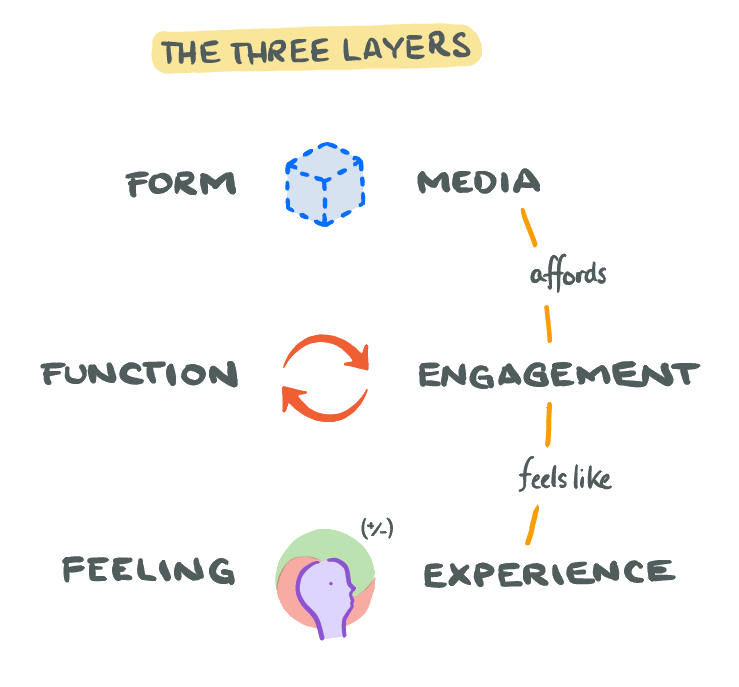 You can think of systems in terms of three layers: the formal layer, the functional layer, and the experiential layer.
You can think of systems in terms of three layers: the formal layer, the functional layer, and the experiential layer.The experiential layer is where value resides. Sadly, it is often left out of important conversations and stays buried under more practical considerations. Ryan Singer (product strategist at Basecamp) points this out while sharing his experience designing a new layout for a barn. From his podcast Synthetic a Priori:
"You could be standing [in the barn] talking [about changing the layout], and it's easy for the conversation to wander off into questions about cost and material and all kinds of valid and reasonable logistical issues. And you could talk through all these logistics and real problems, and you could make a design that satisfies all of them and – insofar as it satisfies those problems – it's a good design solution and it might even have the bulk of the functional issues figured out. But there is one aspect of the requirement set that isn't present in any discussion, and that is, 'when I stand here, how do I feel?' There is just nothing to say about that because it is, indeed, just a feeling." [edited for clarity]
Experience is deemed too chaotic to be worthy of analysis because it is different for everyone. People's individual experience depends on a thousand different things, from their childhoods, to the place they live, the stuff they do for work, and many others. Furthermore, our state of full immersion in our own experience makes it hard for us to think about it as such. This, together with the fact that your individual experience is invisible to everyone else, makes the topic hard to discuss. Yet, it is the most real thing you have. And it may be just a feeling, but it's the feeling we are all here for, as much as we resist to acknowledge.
✎ Connection to